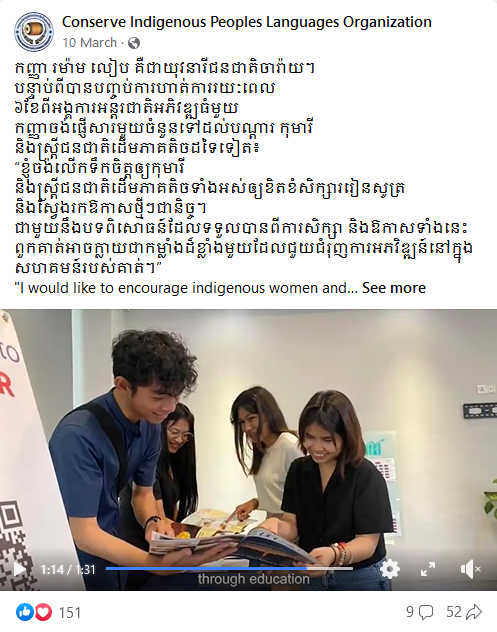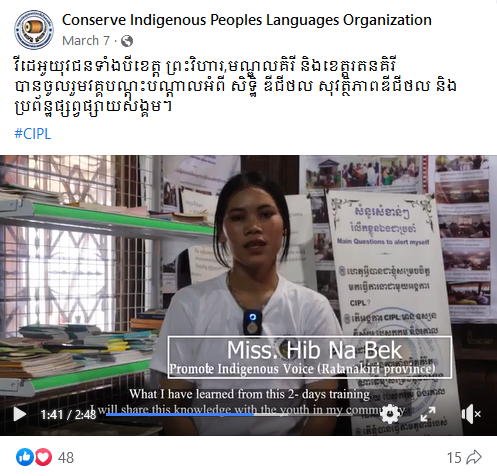CSS produced a short video to highlight the internship experiences of former communications intern and Jarai indigenous youth Romam Leap. The video was very well received by the public on social media, generating approximately 150 reactions, 52 shares, and 2,700 views on Facebook

Similar Stories
Indigenous youths’ improvement on mobile report
Being trained to use a smartphone to report reflects the view of indigenous youth. “This training is very significant for me since I could use it to empower my community and share with outsiders who we are and what we are living with.” Mr. Lao Bundinh is a Jarai indigenous youth. He was born in a rural area of Phork Thom village, Phork Nhai commune, Ouyadav district, Ratanakiri province, and he has lived there for 27 years. He did not have much knowledge of story writing as well as photos and video shooting. However, he would like to share his daily life as an indigenous youth, his livelihood, and culture, as well as the environment in his community with other people through social media. Mr. Lao Bundinh was sharing how to cut the video by using smartphone during the mobile report training provided by CIPL. Until when he got to know about the mobile report training organized by Conserve Indigenous Peoples Languages (CIPL) in collaboration with Open Development Cambodia (ODC), he had the chance to learn what he liked and waiting for. He joined the mobile report training, which aims to build the capacity of indigenous youths on how to use a mobile phone to report on natural resources management by writing stories and using photos as the evidence-based mechanism on 21 – 22 September 2022 in Ratanakiri province. It required him to put more effort and time into improving his skills. Indigenous youths were joining the training on the mobile report provided by CIPL at Ratanakiri province. His commitment to sharing what is happening within his community inspired him to persevere through the challenges. Currently, he can write a story and edit a video to share on the social media platform. He feels very thankful for the organizer giving him an opportunity to learn what he always wishes to. He posted his own video, “Finished the mobile report training on environment, video shooting, and video editing from CIPL, I could do some practices,” to illustrate the beauty of the forest, environment, and livelihood of his community on social media.
Data storytelling by data visualization trainees
Data is an essential component of every organization and journalist. Finding the value in data and communicating that value to your target audience needs time. Simply displaying spreadsheets with rows of numbers is insufficient for demonstrating the significance of data. However, when data is presented in the form of a story, individuals are more likely to appreciate its significance and respond accordingly. The good news is that people enjoy reading stories. Storytelling has long been a great tool for educating, explaining, and influencing a specific audience or intended activities. On 20-21 and 26 December 2022, ODC conducted training on “Data Visualization and Storytelling” to equip participants with basic data visualization and storytelling skills. The trainees have learned about the principle of data as well as using data for product visualization and short storytelling. Even though we have a short time, our trainees could produce such a visualization and combine it into a story that could present data. Note: The stories shown do not have further assessment or review. These are just participants\' practice exercises only. Story 1: The special economic zones in Cambodia The trainees produced storytelling by using visualization named \"Most of Cambodia\'s special economic zones do not unveil the specific companies\' number.\" The special economic zones in Cambodia do not show the specific number of companies, indicating that they are still in the planning stages and are not yet operational. It is critical to take more action and complete those projects with high investment capital that follow the regions. Cambodia\'s potential economic zones include Phnom Penh, Kandal, Preah Sihanouk, Svay Rieng, and Koh Kong, based on data. Story 2: Hydropower dam along the Mekong River and energy consumption Visualizations are used to illustrate the number behind the Mekong hydropower dam. Cambodia, Thailand, Laos, Myanmar, and Vietnam all have one thing in common: they would like to build a dam. As regional and global energy consumption and concern about climate change grow, one solution that can help address both at the same time is building hydropower dams in the Mekong region. Vietnam is the leading country in terms of energy consumption, with numbers steadily increasing up until the recent 2020 deadline. One thing is certain: electricity consumption is rising in all countries and shows no signs of slowing. A number of hydropower projects are planned across the five Mekong countries. Myanmar has the most hydropower plans, with a total capacity of 61,412.1 MW. However, the majority of the plans are still in the planning stages, despite the fact that Vietnam has the highest hydropower project operational rate. Renewable energy\'s future is bright, but some argue that it has taken far too long. Story 3: The most potential hydropower sites in Cambodia Our Trainees also used hydropower data from the ODC website to show which provinces have a lot of hydropower. The results show that the majority of hydropower dams are located in Cambodia\'s northeast, specifically in the provinces of Kratie, Stung Treng, and Ratanakiri. Kong Koh province also has a large number of hydropower dams. Story 4: Cambodia\'s deforestation in the last 20 years Indigenous youth from Ratanakiri province created a short story titled \"Is the forest in Cambodia truly lost?\" based on Global Forest Watch data. Data on deforestation in Cambodia show a significant increase from 2001 to 2010 but a slight decrease from 2011 to 2021. Story 5: Fishing trend by region between 2009 and 2019 in Cambodia In the short storytelling using visualization \"Fishing Activities by Zones,\" fishing zones such as the plain zone, Tonle Sap zone, plateau/mountain zone, and coastal zone are depicted. Cambodia has 20 provinces with Community Fisheries (CFi). In comparison to the other 19 provinces, Koh Kong Province has the most CFis, followed by Pursat and Prey Veng. The CFis in Svay Rieng is the fewest.
CIPL’s video on digital rights and social media training
The training covered the topics of human rights, digital rights, digital media, and digital trends in Cambodia. Pre and post-test results illustrated that 73% of the trainees improved their knowledge regarding digital security and rights.


